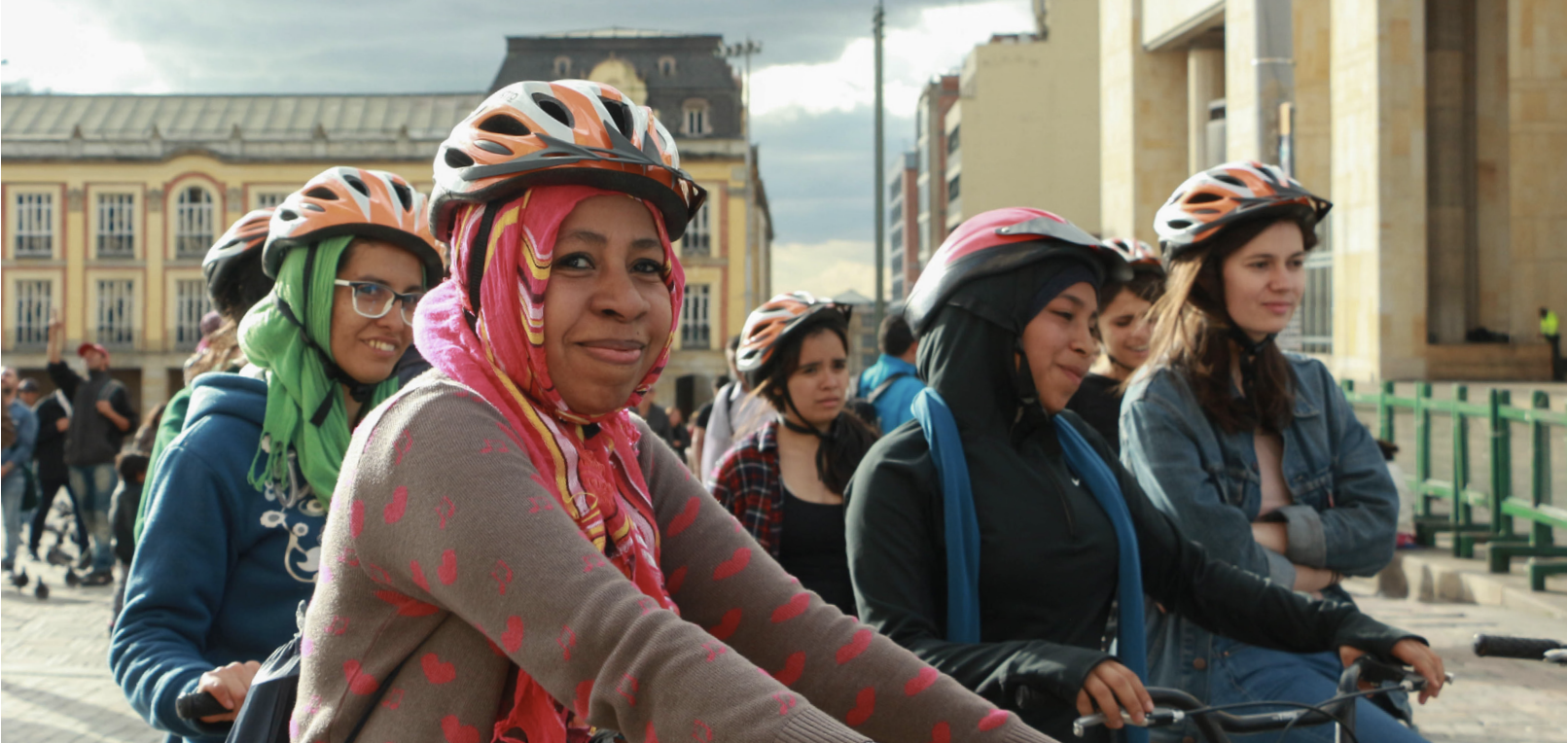Case Study developed by Salat, Serge. 2022. Urban Morphology and Complex Systems Institute 2022. © UMCSII.
Mapping street safety for women and girls in bogota, colombia
Bogotá has shifted towards sustainable transport. A world-class BRT system, TransMilenio, and an extensive cycle-path network have changed mobility in the largest city in Colombia and made it more inclusive and sustainable. However, these improvements are not enjoyed equally by women and men, mostly due to security issues. An application created in India can help make public transport and public spaces in Bogotá more inclusive and safer for women and girls. The case study proposed here provides lessons for policymakers to create more inclusive and healthy communities with a place for everyone.
Key partners and actors
Bogotá has implemented a series of initiatives led by the Secretariat for Women and Gender Equality (SDMujer), the District Department of Mobility (SDM) and TransMilenio SA (TMSA) with the aim of improving the quality of life, safety, and mobility experience for women. At the international conference ‘Safe Cities’ in 2013, SDMujer learned about SafetiPin, an innovative, real-time mapping app developed in India and used to collect, analyse, and disseminate information to make public spaces safer for women.
After translating the app into Spanish, SDMujer partnered with the women’s security council of each district to help point out unsafe areas, such as river banks which are not accessible by car. By taking advantage of the extensive bike-path network in Bogotá, bicycles were used for the first time to audit safety. This led to the audit of 400 kilometres and the improvement of bikers’ safety with measures such as fixed lights, bike racks, and CCTV cameras.
About Bogotá
Bogotá is both the capital and the largest city of Colombia. In recent years, it has experienced a profound transformation towards non-motorized transport (NMT) in its infrastructure planning and policies. Since 1998, the city has been pursuing a shift from a car-oriented transportation system to a people-centred one. To achieve this, Bogotá prioritised the development of bus lanes and bike paths and dedicated more spaces to pedestrians by clearing sidewalks from parked cars, creating new parks and rehabilitating existing public spaces. Because of this vision, Bogotá today now reports a growing bicycle-path network of 344 kilometres and a well-developed BRT system that provides 2.2 million daily trips over 113 kilometres. A partial ban on cars on certain routes and the introduction of car-free days further contributed to the strong culture of walking, cycling, and using public transport.
Source: TUMI
Bogotá’s TransMilenio
While the long-awaited metro line is under construction, Bogotá’s public transport relies heavily on the TransMilenio. This world-class bus rapid transit (BRT) system represents about 25 percent of all transit trips in the Colombian capital. The implementation of TransMilenio was so successful that it became a model for several cities in the country. Since the inauguration of its first phase in 2000, TransMilenio has decreased the average travel time by 32 percent. It has increased property values along the main line by 15–20 percent. It has enhanced tax revenues, created thousands of direct and indirect jobs, reduced traffic accidents by 50 percent in all corridors, improved air quality, and even generated approximately USD 894,737 per year in direct carbon credits. Financed 70 percent by the national government and 30 percent by the local government, the total investment in infrastructure of phases I, II, and III totalled USD 2,040,433.88.
TransMilenio is the first mass transit project registered with the UNFCCC for Clean Development Mechanisms (CDM) in 2006.
With 2.2 million passengers daily, TransMilenio has contributed positively to mobility in the city. There is still room for improvement, though: its crowded buses create the perfect environment for sexual harassment. Bogotá ranked first on a list of worst cities for women in public transport, including the 15 world largest capitals.
Women and Public Transport in Bogotá
Studies on mobility, which consider gender-related responsibilities, show that women move differently than men:
1. Women’s travel patterns are more complex than men’s, with more stops used.
2. Women have less access to private motorised modes of transport and depend on public transportation more.
3. Women, who are traditionally responsible for transporting children, need barrier-free units designed for safe transport with children.
Six out of ten women in Bogotá travel by public transport and 51 percent of the trips made by women are walking compared to 39 percent by men. Alarmingly, nine out of ten women feel unsafe in public spaces in Bogotá: public streets ranked least safe, with 90.5 percent of respondents feeling unsafe on them, followed by public transport stops with 86.3 percent of respondents feeling unsafe. In 2014, 64 percent of the respondents claimed they were victims of sexual harassment while on public transport. While the majority of harassment cases do not involve physical contact, it is essential to create a sense of safety for women to have access to public spaces.
Source: TUMI
Bogotá’s Pilot Projects Against Sexual Harassment
Bogotá has taken the safety issues of women’s mobility seriously and has implemented a series of initiatives led by the Secretariat for Women and Gender Equality, the District Department of Mobility (SDM) and TransMilenio SA (TMSA). The aim is to improve the quality of life, safety, and mobility experience for women. In 2014, Bogotá introduced women-only sections in its TransMilenio buses, along with an awareness-raising campaign and training for workers, such as ticket vendors, advertisers, and drivers. This initiative managed to provide visibility to sexual harassment in public transport and turned it into an issue to address in the public debate. However, the campaign ended in 2016 as it produced little change in dynamics and in the rampant number of sexual harassment cases against women. In 2014, an ‘elite group TransMilenio’ was established and patrolled the TransMilenio buses and stops with the aim to apprehend the rising number of sexual aggressors. The ‘elite group’ captured 16 men red-handed in the first 20 days of operation.
In Colombia, 25 percent of men ignore sexual harassment is a crime. Some even consider it a compliment for women.
This initiative sent a signal to those men, even if the outcomes were difficult to monitor. Instead of creating women-only spaces and prescribing methods for the victims to reduce their risk, it focused attention, resources and debate on the perpetrators and their crimes.
Leveraging Technology to Map Out Safety in Bogotá
At the international conference ‘Safe Cities’ in 2013, SDMujer learned about SafetiPin, an innovative, real-time mapping app developed in India and used to collect, analyse, and disseminate information to make public spaces safer for women. The safety audit, which can be crowdsourced, quantifies nine parameters including lighting, public transport, visibility, and security, and creates a pin which appears on the app with its safety score. Apart from the risk prevention function of helping women make safer decisions, the app allows users to gather real-time data of good quality, validity and relevance for city policymakers and stakeholders to enhance safety in public spaces. After translating the app into Spanish, five taxis drove around Bogotá with mobile phones mounted on their windshields for three months. By taking pictures automatically every 50 metres, about 17,000 pins were collected and categorised. Bogotá’s road network comprises 15,547 kilometres, out of which taxis can drive only 4,000 kilometres. SDMujer partnered with the women’s security council of each district to help point out unsafe areas, such as riverbanks which are not accessible by car. By taking advantage of the extensive bike-path network in Bogotá, bicycles were used for the first time to audit safety. This led to the audit of 400 kilometres and the improvement of bikers’ safety with measures such as fixed lights, bike racks, and CCTV cameras. The strategies are aligned with the common vision of Green and Thriving Neighbourhoods.
Bogotá’s Night Safety Index
Challenge Winner, SDMujer, with SafetiPin and CAF, is planning to gather and audit georeferenced data according to eight variables. These variables make up the index for 15,547 kilometres of streets within the city of Bogotá. They are: (1) quality and quantity of lighting, (2) openness/blind spots, (3) visibility, (4) pedestrian density, and (5) security staff in the area (6) availability and quality of pathways, (7) public transport, and (8) diversity of people in gender and age. 12,000 face-to-face interviews will be conducted in areas next to public transport stations. The aim is to study the perception of insecurity and harassment. This will lead to the creation of a night safety index for women, the first one encompassing all 19 zones of the city. To present key findings, encourage dialogue and public debate on women’s and girls’ safety in public spaces and inspire other cities, an international event will be organised. The project will aim to implement selected improvement measures in the least safe areas identified. In this project, women are their actors of change by taking part in the data collection, shaping recommendations for improvements and awareness campaigns and events, and taking concrete actions. The project aims to generate a public debate and to trigger a change in citizens’ behaviour in a culture ignoring sexual harassment as a form of violence. Bogotá aspires to inspire other cities to explore and adopt similar solutions to make their public transport and spaces truly inclusive.
Source: TUMI
Lessons for Learnt
The challenge for the city was, firstly, to acknowledge the issues of insecurity and sexual harassment, spreading awareness across the population. Secondly, a strategy and set of actions needed to be undertaken to tackle and reduce the issues. The solution presented in this case study can inspire and be also used in other cities facing similar concerns. Real-time mapping tools can help collecting, analysing, and disseminating data to make public spaces safer for women. This approach can also be applied to other issues undermining safety and equality. Leveraging data can help increase awareness, expand the understanding of urban phenomena, and find solutions to latent needs.
References
Tu My Tran 2019. Bogotá, Colombia: Leveraging technology and data to map street safety for women and girls. TUMI.




